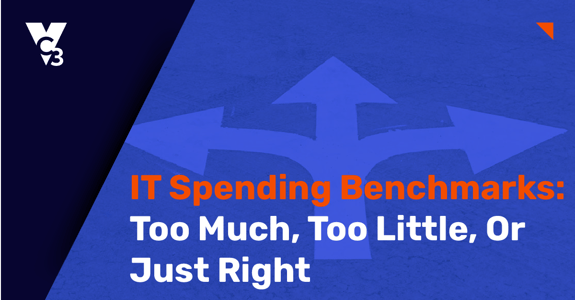How Much Should You Spend on IT?
Some organizations overspend on information technology and get frustrated by a lack of return on their investment. It’s easy to let hardware, software, and support costs get out of control.
Others underspend and sink into technical debt—calculated as the future cost of taking IT shortcuts. Such organizations experience ramifications including efficiency losses, operational disruption, permanent data loss, and competitive disadvantage.
It’s likely you agree that you need a “just right” spending strategy. But how do you know if you’re overspending or underspending on IT? How do you allocate your technology dollars and build a technology budget that aligns with your organization’s strategy and drives value?
In some ways, it’s like the story of “Goldilocks and the Three Bears.” IT spending needs to be “just right.” But what does “just right” look like?
While IT spending can vary for every organization and industry, there are three common starting points for benchmarking.
IT Spending by Industry and Percent of Revenue
According to a report by Flexera, organizations as a whole budget 8% of revenue on average for information technology. So, for a quick estimate to see if you’re overspending or underspending, start with that simple calculation to see if you might be way off base.
To go a little deeper, you can look at the average IT spending by industry as a percent of revenue. Recent research shows the following benchmarks per industry:
- Software (18%)
- Tech Hosting / Cloud (11%)
- Financial Services (10%)
- Retail and eCommerce (7%)
- Transportation and Logistics (5%)
- Healthcare (5%)
- Consumer Products (3%)
- Industrial Products (2%)
 Image Source: Flexera
Image Source: FlexeraIf you are in a highly regulated industry (such as financial services) with complex compliance requirements, your IT spending will likely be higher.
Should you worry if your organization’s IT spending is higher or lower than the averages listed above? Not necessarily. Your spending may be in line with the needs of your organization.
However, if the benchmark percentage is way off base compared to your organization’s percentage, it may not hurt to take a fresh look at your numbers and how your IT dollars are being spent. You may find some areas where you can reduce spending. Or, there may be areas where you need to spend more.
Related Reading: IT Budget Template
IT Spending by Number of Users
Another benchmark you can use is IT spending based on the number of users. This number will also help determine your IT staffing and equipment needs.
A study, IT Spending and Staffing Benchmarks by Avasant, found that annual IT spending by user averaged $7,614, down from $9,647 in 2022. This steep decrease is a result of organizations moving to the cloud, increasing automation, and other similar IT initiatives that result in operational efficiencies.
This number can be eye-opening because, if your spending per user is too high, it could suggest that you’re not investing in enough modern IT infrastructure and support that can help lower your costs.
Allocation of Funds Toward Innovation
It may seem paradoxical that we’re talking about IT innovation spending in an article focused on controlling spending. However, there is also a “just right” approach to making sure you’re staying competitive, looking ahead to trends that impact your industry, and investing in tools and solutions that could heavily impact the way you do business.
Many organizations conservatively look at IT spending in two buckets – capital expenses and operational expenses. While a tried-and-true approach, you may want to segment part of your budget for innovation—especially if you are in a very competitive industry.
IT can roll into your overall innovation investments, which can vary quite a bit depending on your industry. Across all industries, innovation spending is about 3-4% of total revenue—with percentages as high as 31% for technology companies.
Also consider that 81% of CIOs spend more time on innovation than a year ago and 46% of CIOs say that they are held accountable for continuous innovation by their boards.
When you start looking at your percentage of IT spending on innovation, you can spot some possible areas of opportunity—especially if you’re spending hardly anything. Innovation should connect to your overall mission and strategy, with IT as a support to help you execute your goals. Once you analyze your particular situation, your organization may be able to shift some dollars toward projects that help with customer service, operational efficiency, or digital transformation.
The Big Picture
Gaining visibility into your entire IT spending can be more challenging than it seems. Many organizations spend money on IT outside of a centralized IT budget. While not inherently bad, decentralized IT spending causes you to lose visibility and efficiency. Departments may duplicate IT spending on fractionally used servers, pay more per license for shared software, or not realize a purchase has already been made that can be shared.
To fully understand your position with IT spending, it’s important to view the big picture and make decisions with all information in your hands.
Next Steps
Technology touches every aspect of your organization. To maximize the value of IT, it must align with your organization’s strategy and goals. It is possible to view your technology spending as an investment in efficiency instead of a sunk cost.
Sometimes the answer is to spend more. In other cases, it’s a prioritization game. Many different angles must be considered to maximize the potential value of IT. That’s why a strategic technology partner, who can provide guidance and oversight, is so vital.
Struggling to build a technology budget that supports your users and drives value creation? Complete the form below and we will schedule a short call with you to learn more about your organization’s IT needs.


